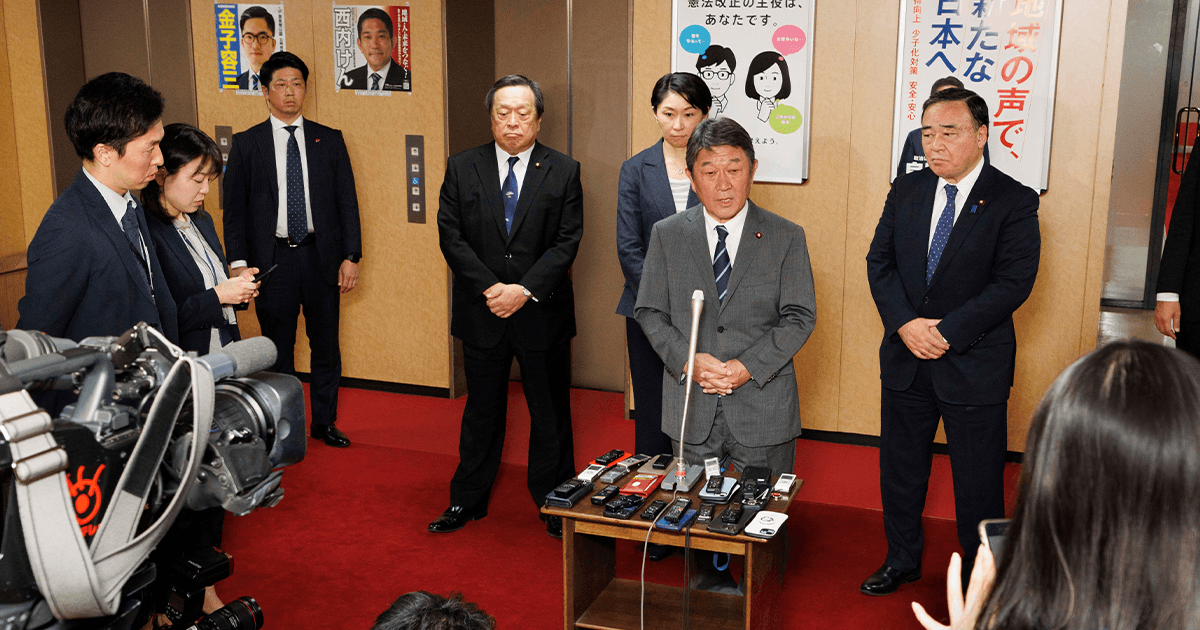Kishida's autumn of discontent
Another disappointing by-election is just one of the PM's problems
Motegi Toshimitsu spoke bluntly on Sunday:
It was undoubtedly a tough election campaign.
The LDP’s secretary-general was, of course, referring to the results of two by-elections on Sunday, 22 October, for an upper house seat in the Tokushima-Kochi joint constituency and a lower house seat in Nagasaki’s fourth district.
Hirota Hajime, a former upper house member, backed by the Constitutional Democratic Party (CDP), the Japanese Communist Party, and other opposition groups – excluding Ishin no Kai – defeated Nishiuchi Ken, the ruling coalition’s candidate, by roughly 90,000 votes. In Nagasaki, the LDP’s Kaneko Yōzō prevailed over the CDP’s Suetsugu Seiichi, by a comfortable but not overwhelming margin of 7,016 votes (roughly seven percentage points).
The LDP, however, could take little comfort from the victory in Nagasaki. Not only had the party hoped to win both contests – arguably Prime Minister Kishida Fumio needed the party to win both contests.
Kishida went into Sunday’s by-elections with his approval ratings mired at their lowest levels of his tenure. In Mainichi, his approval has been below thirty percent for four months, and for the past two months, his numbers have been identical: 25% approval, 68% disapproval, a net approval of -43. In Kyodo, his approval fell 7.5 points this month to a record-low of 32.3%, while his disapproval climbed nearly thirteen points to 52.5%, a twenty-point decline in the government’s net approval. What is particularly grim for Kishida is that these numbers came after he played a series of cards intended to improve his fortunes. He reshuffled his cabinet. His government, after a lengthy investigative process, moved to revoke the Unification Church’s status as a tax-exempt religious corporation. On the eve of the by-elections, he ordered the ruling parties to consider an income tax cut as part of a forthcoming stimulus package. Now, in his policy speech opening the extraordinary session of the Diet, delivered on Monday, 23 October, literally said that his main focus will be “the economy, the economy, the economy,” which sounds like a transparent bid to persuade voters that he’s taking public concerns about rising prices seriously.
It is hard to avoid the impression that the prime minister is flailing about in search of something – anything – to improve his fortunes and enable him to call a snap election that could give him new political life and improve his chances of securing a new leadership term in September 2024.
By-elections can be over-interpreted. Marginal elections in which turnout was significantly lower than the already low turnout in recent national elections may not perfectly encapsulate the national mood. With Ishin no Kai candidates absent from both races, the opposition vote was more unified in both constituencies than will likely be the case in the next general election, which could work in the LDP’s favor. Nevertheless, the clock is ticking on Kishida’s fortunes.
The LDP’s backbenchers cannot help but notice exit polls that showed not only independents overwhelmingly voting against LDP-backed candidates – by an 82%-17% margin in the Tokushima-Kochi by-election and 63%-36% in the Nagasaki-4 by-election – but also relatively soft support from LDP supporters. According to Kyodo’s exit poll, only 68% of LDP supporters voted for Nishiuchi and 79% for Kaneko, both figures being lower than the share of Kōmeitō supporters backing the ruling coalition’s candidates, concerns about the health of the coalition notwithstanding.1 There is real discontent abroad in the electorate, and, with less than a year until the party will have a chance to replace Kishida – and another two before a general election must be called – Kishida and the ruling parties will be deep in thought through the end of the year whether they can or should go to the public in the near term.2
And surely some members of the LDP may be asking themselves whether they might do a better job. If Kishida’s “It’s the economy, stupid” pivot fails to connect with voters, those questions may become harder to ignore.
On 26 October, the expanded, paperback edition of The Iconoclast will be available for sale. You can buy directly from Hurst Publishers here.
While the bulk of the text is unchanged, I have written a new introduction, which considers what I call the “two faces” of Abe, and a new afterword, which provides a narrative account of Abe’s assassination; the Unification Church scandal and what it says about Abe; and how Abe continued to influence Japan’s politics after leaving office in 2020 and how he continues to cast a shadow now.
As always, many thanks to those who have already signed up to read these posts. At the moment, I do not plan to shift to a subscription model. However, Substack has introduced the option of “pledging,” indicating a willingness to subscribe if I were to shift to a subscription plan. In the event of a snap election, I may charge for electoral analysis and keep other posts publicly available.
If you would be willing to pay for a subscription, it would be helpful if you could press the “pledge your support” button on the upper right of the page. I will not turn on subscriptions without notice, but I would like to gauge how much interest there might be.
Perhaps even more disconcerting for the LDP is that independents were likely a smaller share of the by-election electorate than they could be in a general election — and Ishin no Kai is of course hoping to mobilize independents (and perhaps also some disaffected LDP voters too).






Thank you for your analysis on Japanese politics. As a long term resident of Japan, I always enjoy reading your take on the political landscape.